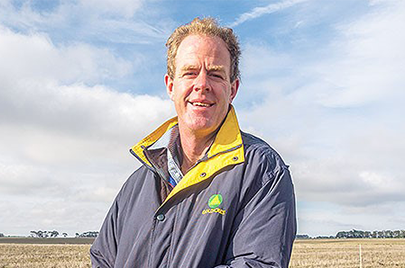Made to measure
| On-Farm Snapshot | |
|---|---|
| Name/s | Craig and Jayne Drum |
| Location | Tatyoon, south of Ararat, Victoria. |
| Area | 240ha |
| Enterprise | Mixed farming with a Merino ewe flock and opportunity sheep trading |
| Livestock | 200 Merino ewes joined to Suffolks for first cross lamb production and trading an additional 200-300 lambs a year |
| Pastures | Sub-clover based with phalaris and ryegrass |
| Soils | Clay over very heavy clay |
| Rainfall | 550mm |
You could be excused for thinking Craig and Jayne Drum measure pasture and feed budget in their sleep. After all, Jane was a technical officer for trials in the MLA supported EverGraze project for two years and Craig is an agronomist.

"Jayne's probably taken a thousand pasture measurements through her work," Craig said. "The problem was we just weren't disciplined in applying what we knew we knew and told others to do in our own enterprise."
To overcome this anomaly and provide rigour to their mixed farming enterprise, the couple are currently working their way through the Managing a Diverse Feedbase program with MLA's Profitable Grazing Systems. The program, which Craig helps facilitate, is delivered primarily by southern Victoria rural consultant Cam Nicholson to a producers through group sessions, farm visits and one-on-one learning over a 12-month period.
Participants, through skills based learning and practice, focus on how to better manage a mixed farming feedbase to meet their livestock production goals. The PGS program is helping Craig and Jayne understand the supply of and demand on their feedbase in a 12-month cycle.
The Drums are relatively new to mixed farming, having started out purely cropping their farm. Six years ago, inspired by the productivity of nearby mixed farmers, the couple introduced Australian White and Dorper ewes. While they were easy care and productive on a farm with no sheep handling infrastructure, their tendency to rub and damage newly erected fencing led to them being swapped for Merino ewes.
While still building up numbers, Craig and Jayne now run 200 ewes, joined to Suffolks for a first cross prime lamb and opportunity trade first or second cross lambs (primarily in 2019 first cross lambs which were grown out on a winter canola crop which failed due to water logging).
Ewes and lambs are grazed on a mix of:
- older phalaris and sub-clover pastures (dominated by phalaris)
- newer perennial rye and sub-clover pastures
- failed winter crops, such as in 2019 when 138mm fell in May, 90mm in June and 80mm in July
- clover hay and feed grain produced on farm.
The challenge was posed by having ewes lambing on 1 April to fit in with demands of on and off farm activities.
"The ideal would be to have ewes lambing on to green pastures but while we get lots of rain, we are in a Mediterranean climate where summer rainfall is very low," Craig said.
By identifying this gap through the PGS training and understanding just how the pastures were performing, Jayne said they've worked on the problem by making two changes - pushing lambing back to the end of April and providing a green food source if possible on lambing The green source coming from sowing earlier grazing crops and they have introduced another feed source for 2020 - a summer crop.
Sown in September, the fodder rape and lucerne stands to benefit from any summer storms and could at least provide feed to pregnant ewes in February/March.
"I've learnt through measuring dry matter and developing feed budgets over and over again in this program, that I was generally overestimating how much feed we did have available," Craig said.
"It's why sheep were taking longer to reach target weights than I'd anticipated."
The Drums believe better feedbase management is a springboard for growing their business - a theory they are testing out by moving into trading lambs when opportunities like failed crops present.
"The PGS style of delivering learning through group sessions and one-on-one learning means you can really get to the bottom of your challenges and sort out what is holding you back," Craig said.
"For us it was just not being rigorous enough in optimising our feed supply and understanding the impact on animal growth. It's a complex business when you are growing crops and running livestock but nowadays every paddock is a feed source at some stage and there a decisions to be made about that every day."
Jayne agreed saying she has found the balance of group discussion with one-on-one time with Cam really beneficial.
"When we sat down with Cam and mapped out our pasture growth for the year and our sheep production system it was clear what changes could be made to our system and both the expected production and financial outcomes," she said.
"Both of us knew these fundamentals from our work and our uni days but the program has reminded us to put them into practice."
As they improve feedbase management, Craig said it will support taking on their next challenge of lifting their lamb weaning rates.
"If we know we are meeting ewe feed requirements better all year round, then we can work on the other factors which impact lamb numbers like genetics," he said.


